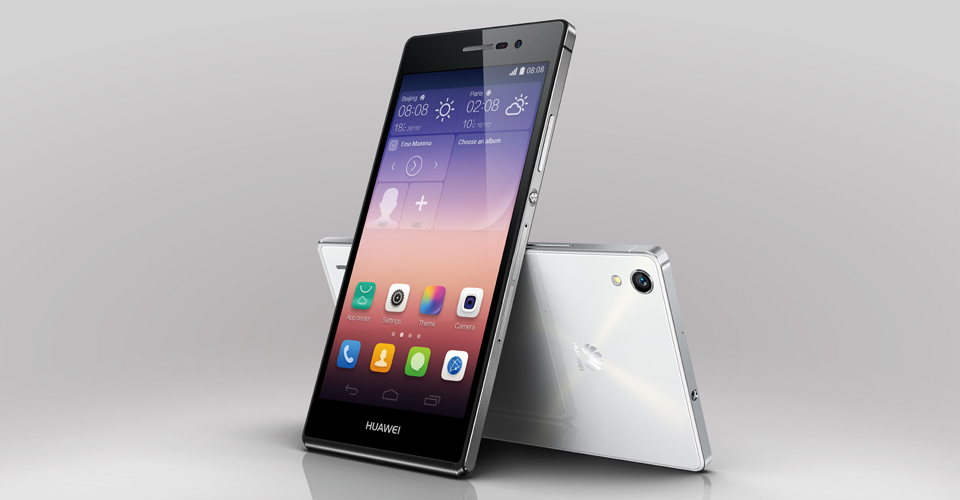REVIEW: Huawei Ascend P7

Huawei has grown to become a firm number three maker of smartphones with a 6.9 per cent market share, according to IDC. While the company does big business in China, Huawei is still a relatively small time smartphone manufacturer in the west.
The Chinese company's newest flagship, the Ascend P7, is the latest attempt to make a name for itself outside its home country but does the handset deliver on the ‘affordable flagship' promise or is it an underwhelming performer doomed to consumer obscurity?
Build quality
Huawei has done a lot of things right when it comes to the overall construction of the phone.
Gorilla Glass 3 protects the front and back of the phone along with a metal frame around the sides. There's no trace of plastic other than the 1mm or so of polycarbonate that sits sandwiched between the glass and metallic band.
There's also a distinct mesh effect design on the back of the phone that gives the handset a subtle classy edge to the package. At 6.5mm, the Ascend P7 is also one of the thinnest smartphones around.
Performance
Huawei has made some heavy customisations to Android 4.4.2 KitKat with its proprietary ‘Emotion UI' skin which takes a few cues from iOS.
The first thing regular Android users are going to notice is that all of the apps are accessible from the multiple pages of the home screen instead of the app tray, which simplifies the software experience especially to those who might be new to Android. You still have the option of adding and removing widgets on the home screen and there's some preloaded such as the weather, music, gallery and Google search widgets.
Unfortunately, there were noticeable stutters throughout the OS, for example, when pulling down the notification shade, jumping between open apps and when swiping between pages of the home screen. We also noticed a five second delay whenever we attempted to view photos in the gallery after taking a burst shot.
The phone would, on occasion, crash and restart a problem that tended to rear its head when there were a lot apps updating in the background.
Don't expect to find the latest piece of Snapdragon silicon from Qualcomm under the hood with Huawei, instead, opting for a homemade setup consisting of a 1.8GHz CPU and Mali-450 GPU with 2GB of RAM.
Benchmarks suggest internals are underpowered by some margin in comparison to Android flagships such as the Samsung Galaxy S5 and HTC One M8.
Camera
The camera is an area where Huawei has, at least on paper, splashed some cash.
In a move that's sure to please selfie addicts and regular video callers alike, the Ascend P7 comes equipped with a gob-smacking 8MP front facing camera, the highest available on the market, beating out other top flight Android handsets such as the HTC One M8 (5MP) and Galaxy S5 (2MP). Around back, there is a 13MP camera that is powered by Sony's BSI sensor.
Taking shots out in the QLD sun produced some great looking pictures with the images looking bright, clean and detailed. There's also an impressive ‘Ultra Snapshot' feature which takes a picture from standby within a second of double-pressing the volume down button.
Low light performance doesn't hold up as well as the HTC One M8 or the Sony Xperia Z2 with photos coming out on the murky side.
While you won't find high-end features like 4K video recording and Optical Image Stabilisation (OIS), the camera punches well above its weight for a mid-range priced smartphone, edging out the likes of the Nexus 5 and Moto X.
Battery life
The Ascend P7 comes with a 2500mAh battery. That's not quite as large as top-end smartphones like the Galaxy S5 (2,800mAh) and Sony Xperia Z2 (3,200mAh), however, it is generally bigger than what you will find in other sub-$600 smartphones.
The battery holds up poorly in day-to-day use and the unit was always completely drained before the end of the day. The Ascend P7 also does a terrible job of holding a charge as the battery drains away in the background even while on standby, meaning that the handset will require a charge on a daily basis regardless of usage.
The verdict
When it comes to the camera and overall build quality, the Huawei Ascend P7 holds its own against other sub-$600 smartphones. As an overall package, however, the handset fares poorly with a middling software experience and a below average battery life.
At a suggested retail price of $549, the Huawei Ascend P7 is a hard sell when Google's more powerful and better performing Nexus 5 can be had for $149 less.
















